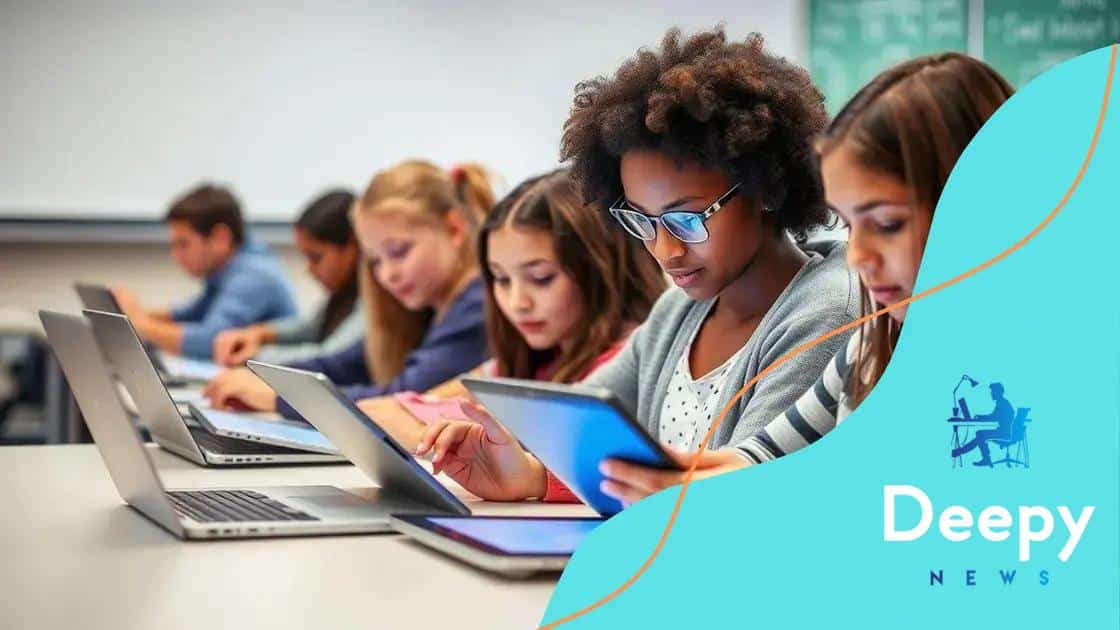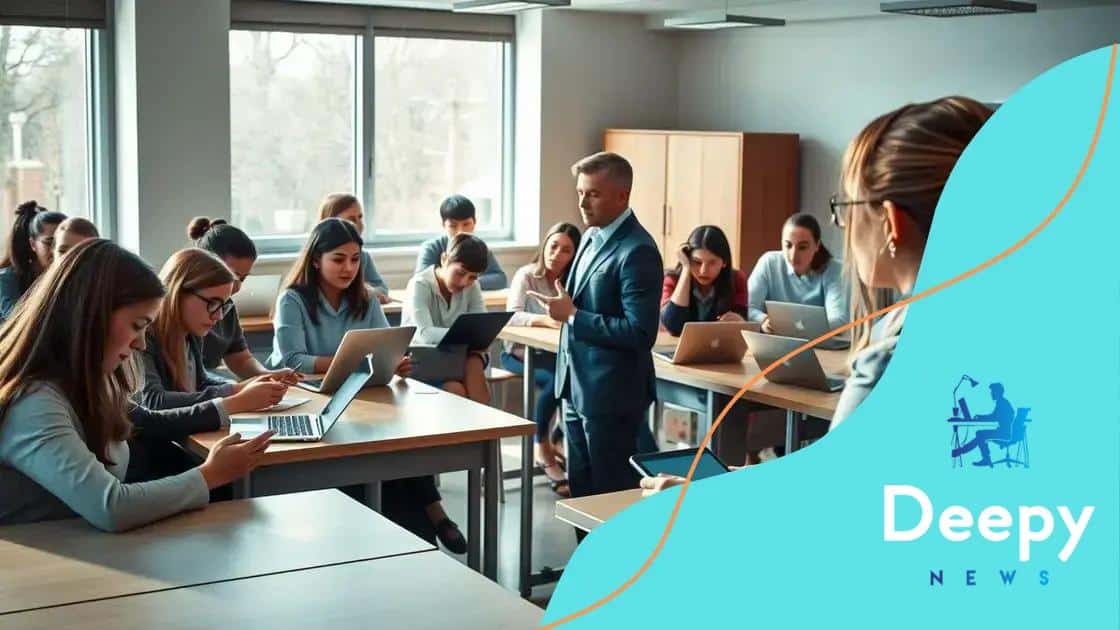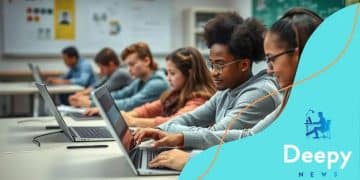The shift from traditional textbooks to digital learning materials

The shift from traditional textbooks to digital learning materials enhances engagement, personalization, and accessibility, transforming the educational experience for students across various learning environments.
The shift from traditional textbooks to digital learning materials is reshaping how students learn today. Have you ever wondered how this transformation impacts education and your experience?
Overview of digital learning materials
Digital learning materials are changing the way we approach education. These resources offer an engaging and interactive way for students to learn compared to traditional textbooks. With the rise of technology in classrooms, understanding these materials becomes essential.
What are Digital Learning Materials?
Digital learning materials encompass a wide range of interactive content, including e-books, videos, and online courses. Unlike static textbooks, digital resources allow for dynamic content that can be updated and personalized.
Benefits of Digital Learning Materials
Using digital materials provides several advantages:
- Accessibility: Students can access materials anytime and anywhere.
- Engagement: Interactive elements like quizzes enhance learning.
- Customization: Learning paths can be tailored to individual needs.
Additionally, these resources promote collaboration among students and teachers. They can share notes, participate in discussions, and work on projects together, leading to a more unified classroom experience.
Incorporating Digital Learning Materials
Teachers are increasingly integrating digital materials into their lessons. By doing so, they make learning more relevant and connected to the digital world. As a result, students often find subjects more interesting and easier to understand. It’s important for educators to receive training on utilizing these resources effectively.
As digital learning continues to evolve, it is crucial to stay informed about the latest trends and technologies. This ensures that both teachers and students are equipped with the tools needed for a successful educational experience.
Benefits of digital over traditional methods
The benefits of digital learning materials compared to traditional methods are vast and impactful. By leveraging technology, education becomes more engaging and effective. This shift enhances the overall learning experience for students.
Enhanced Engagement
Digital resources often include interactive elements that boost student participation. This helps maintain students’ attention and fosters enthusiasm for learning. For example, quizzes and games make learning fun and interactive.
Convenience and Accessibility
With digital materials, students can access their learning resources anytime, anywhere. This flexibility allows them to learn at their own pace, making it easier to revisit challenging topics. Additionally, many resources are compatible with various devices like tablets, laptops, and smartphones.
- Instant Updates: Digital materials can be updated quickly, ensuring students have access to the latest information.
- Cost-Effective: E-books and online resources often cost less than printed textbooks.
- Personalized Learning: Digital platforms can adapt to individual learning styles and needs.
Integrating digital learning materials in classrooms leads to improved collaboration among students. They can work on shared projects using cloud-based platforms, share files, and provide feedback to each other seamlessly. This collaborative approach not only enhances learning but also builds important social skills.
Environmental Impact
Choosing digital over traditional methods also helps reduce paper waste, contributing to a greener planet. Schools can diminish their carbon footprint by minimizing printing and distributing physical materials.
As we witness advancements in technology, the educational landscape continues to evolve. The transition to digital learning methods offers students invaluable skills they need to thrive in today’s digital world.
Challenges in transitioning to digital

Transitioning to digital learning materials presents several challenges for educators and students. While the benefits are significant, understanding these obstacles is crucial to navigating the shift effectively.
Resistance to Change
Many educators and institutions may feel hesitant about adopting new technologies. This resistance can stem from a lack of training or familiarity with digital tools. Overcoming this barrier is essential for a successful transition to digital resources.
Technical Issues
Technical difficulties can be a significant challenge during the transition. Schools may face problems such as insufficient hardware or unreliable internet connections. Addressing these technical issues is vital to ensure smooth access to digital materials. Additionally, schools need to invest in reliable systems and infrastructure to support digital learning.
- Training Requirements: Educators might require training to use new digital tools effectively.
- Resource Limitations: Some schools may not have adequate funding for technology and digital content.
- Compatibility Issues: Digital materials must be compatible with different devices.
Furthermore, not all students have equal access to technology at home. This digital divide can lead to disparities in learning opportunities, making it crucial to provide support for underprivileged students. Schools must find innovative ways to bridge this gap, whether through lending programs or community partnerships.
Maintaining Engagement
Lastly, while digital materials can enhance engagement, they also require careful management. Teachers must ensure that students stay focused and motivated during digital lessons, which can be challenging in a tech-heavy environment. Developing strategies to keep students actively engaged is vital to foster a positive learning experience.
By assessing these challenges and finding ways to address them, schools can create a more effective and inclusive digital learning environment.
How schools are adapting to changes
Schools are adapting to changes by incorporating digital learning materials into their curricula. This shift allows educators to create a more engaging and interactive environment for students. By embracing technology, schools can enhance the educational experience and improve learning outcomes.
Professional Development for Educators
To successfully adapt, schools are providing professional development for educators. This training helps them learn how to effectively use digital tools and resources. Educators are discovering how to blend traditional teaching methods with digital innovations.
- Workshops: Many schools offer workshops to teach teachers about new technologies.
- Peer Collaboration: Teachers often share strategies and techniques to enhance digital learning.
- Online Courses: Educators can access online courses to learn at their own pace.
Furthermore, schools are investing in the necessary technology infrastructure. Reliable internet access and up-to-date hardware are essential for successful digital learning. Some institutions have even implemented one-to-one programs, providing each student with their own device.
Integrating Digital Content into Curriculum
Another way schools are adapting is by integrating digital content into their curriculum. This includes using e-books, interactive simulations, and educational software. These resources offer students a rich and varied learning experience. They allow for personalization and instant feedback, making learning more effective.
Collaboration with technology companies also plays a significant role. Schools partner with tech firms to gain access to innovative resources and training. These partnerships can lead to tailored solutions that meet the specific needs of students and educators.
As schools continue to navigate this transition, they are finding new ways to enhance education. By embracing digital learning, they are preparing students for a future where technology is essential in everyday life.
Future trends in digital education
The future of digital education is set to bring exciting changes and innovations. As technology continues to advance, schools and educators are adopting new methods to enhance the learning experience. Understanding these trends is key to preparing for the future.
Artificial Intelligence in Education
Artificial Intelligence (AI) is becoming a significant part of education. It can personalize learning experiences for students by analyzing their performance and preferences. This allows educators to tailor lessons to meet individual needs, making learning more effective.
- Smart Tutors: AI-powered smart tutors can provide immediate feedback to students, helping them master topics quickly.
- Data Analytics: Schools can use data to identify trends and areas where students struggle, enabling targeted interventions.
- Automated Administrative Tasks: AI can help manage schedules and grading, giving teachers more time to focus on instruction.
Moreover, blended learning models are gaining traction. Traditional classroom methods combined with online components create a flexible learning environment. This approach allows students to learn at their own pace while also benefiting from face-to-face interactions.
Virtual and Augmented Reality
Another trend is the use of Virtual Reality (VR) and Augmented Reality (AR) in education. These technologies immerse students in interactive environments, making learning more engaging. For instance, students can explore historical sites or conduct experiments safely in a virtual lab without any risks.
The integration of gamification is also influencing digital education. By making learning fun through game-like elements, students are more likely to engage with the content. Features like points, levels, and badges can motivate students to participate actively in their education.
As we look ahead, the role of technology in classrooms will only expand. Schools and educators will need to keep pace with these trends to ensure students gain the skills they need for a successful future in an increasingly digital world.
FAQ – Frequently Asked Questions about the Shift to Digital Learning Materials
What are the main benefits of using digital learning materials?
Digital learning materials enhance engagement, allow for personalized education, and offer flexible access for students.
How can schools overcome the challenges of transitioning to digital?
Schools can provide professional development, ensure reliable technology, and create inclusive strategies to support all students.
What technologies are shaping the future of digital education?
Emerging technologies like artificial intelligence, virtual reality, and gamification are transforming the educational landscape.
How can educators ensure students remain engaged in a digital learning environment?
Educators can use interactive content, maintain communication, and incorporate collaborative projects to keep students actively involved.






